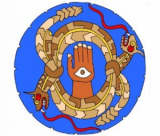Religious Symbols Page #6
This page lists all the various symbols in the Religious Symbols category.

Religious symbolism is the use of symbols, including archetypes, acts, artwork, events, or natural phenomena, by a religion. Religions view religious texts, rituals, and works of art as symbols of compelling ideas or ideals. Symbols help create a resonant mythos expressing the moral values of the society or the teachings of the religion, foster solidarity among adherents, and bring adherents closer to their object of worship.
Symbols in this category:
Fraternitas Saturni
Fraternitas Saturni (lat.: "Brotherhood of Saturn") is a German magical order, founded on Easter 1928 by Eugen Grosche aka Gregor A. Gregorius and four others.
Globus cruciger
The globus cruciger (Latin) is an orb (globus) topped with a cross (cruciger), a Christian symbol of authority used throughout the Middle Ages on coins, iconography and royal regalia. It symbolises Christ's (the cross) dominion over the world (the orb), literally held in the dominion of an earthly ruler (or sometimes celestial being such as an angel). The first known use was in 423 on the reverse side of the coins of Emperor Theodosius II.
Grapes
The symbolism of the grape is invariably tied to, and often overshadowed by, its fermented after-product- wine. Insofar as the two can be pried apart, this article will attempt to do so, and focus primarily on the fruit itself.
Hamsa
The hamsa (Arabic: خمسة khomsah, also romanized khamsa, meaning lit. "five") is a palm-shaped amulet popular throughout the Middle East and North Africa, and commonly used in jewelry and wall hangings. Depicting the open right hand, an image recognized and used as a sign of protection in many societies throughout history, the hamsa is believed to provide defense against the evil eye.
Hand Eye Symbol
The Hand Eye symbol featured strongly in the Mississippian culture. The following picture shows the Hand Eye Symbol surrounded by the Horned Serpent.
Hand Eye Symbol #2
The Hand Eye symbol featured strongly in the Mississippian culture. The following picture shows the Hand Eye Symbol surrounded by the Horned Serpent.
Happy Human
The Happy Human is an icon and the official symbol of the International Humanist and Ethical Union (IHEU), a world body of Humanist organizations, and has been adopted by many Humanist organizations and individuals worldwide.
Helm of Awe
Aegishjalmur, also called Ægishjálmur is an ancient protective talisman of the Norse ---but the true nature of its magic has many interpretations. In icelandic sagas it can be found to confer power and dominance in conflict. To instill fear in one's enemies and to conquer fear in one's own mind. And while its literal translation is "Terror Helm", it is believed that it was never actually a helm, but rather something worn impressed or imprinted upon the forehead.
Hippopotamus
The hippopotamus is an extremely powerful animal, both on land and in the water. Its massive size and fierce demeanor, yet also its association with fertility, all contribute to its potent symbolic meaning.
Honey
The cultural importance of honey is based, in large part, on its sweet flavor. While some symbolic meanings of this foodstuff are easy to understand, others may come as quite a surprise.
Ichthys
Ichthys (also Ichthus or Ikhthus /ˈɪkθəs/[1]), from the Koine Greek word for fish: ἰχθύς, (capitalized ΙΧΘΥΣ or ΙΧΘΥϹ) is a symbol consisting of two intersecting arcs, the ends of the right side extending beyond the meeting point so as to resemble the profile of a fish.
Ik Onkar
Ik Onkar is the symbol that represents the One Supreme Reality and is a central tenet of Sikh religious philosophy. Ik (ਇੱਕ) means one and only one, who cannot be compared or contrasted with any other, (ਓਅੰਕਾਰ) is the one universal ever flowing divine melody and existential unstuck never ending sound of God.
Illuminates of Thanateros
The Illuminates of Thanateros is an international magical organization focusing on practical group work in chaos magic. The idea was first announced in 1978, while the order proper was formed in 1987. This fraternal magical society has been an important influence on some forms of modern occultism.
Italo-Roman neopaganism symbol
Italo-Roman Neopaganism, known variously as Religio Romana (Roman religion) in Latin, the Roman Way to the Gods in Italian and Spanish, is a contemporary reconstructionist movement reviving traditional Roman and Italic religious cults consisting of loosely related organizations.
Citation
Use the citation below to add this symbols category to your bibliography:
Style:MLAChicagoAPA
"Religious Symbols." Symbols.com. STANDS4 LLC, 2024. Web. 23 Apr. 2024. <https://www.symbols.com/category/5/Religious+Symbols>.
















Have a discussion about the Religious Symbols category with the community:
Report Comment
We're doing our best to make sure our content is useful, accurate and safe.
If by any chance you spot an inappropriate comment while navigating through our website please use this form to let us know, and we'll take care of it shortly.
Attachment
You need to be logged in to favorite.
Log In